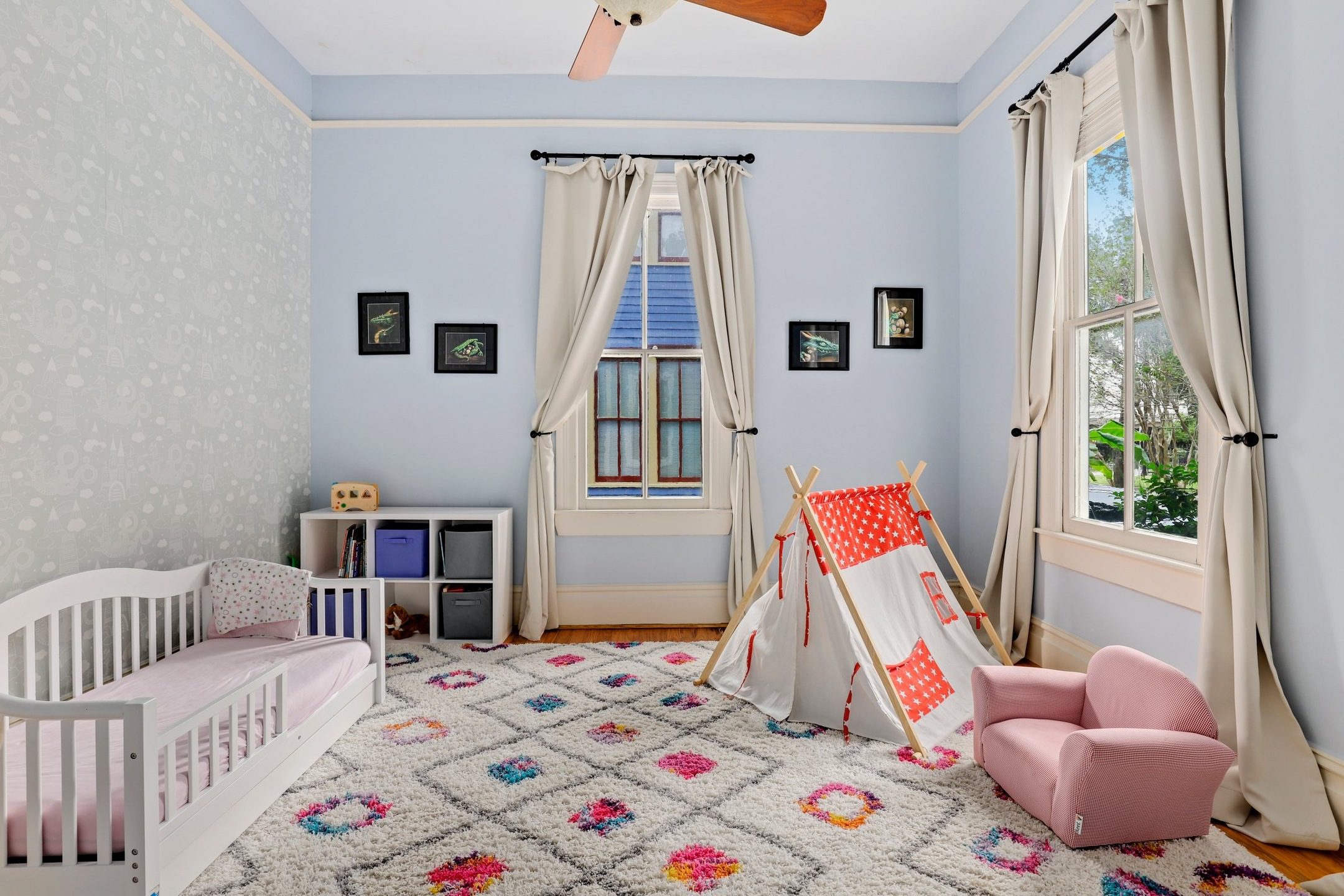
14 Jun Spark Creativity in Your Home! 21 Inspiring Kids Playroom Decor Ideas
Originally published by Redfin
Imagination and kids go hand-in-hand. And when it’s playtime, a kids playroom should be filled with toys that spark their imagination and creativity. Whether that’s with a kitchen playset for a child that loves the idea of being a chef or a table for all sorts of arts and crafts, the options are endless. If you’re looking for a way to highlight your child’s creative mind in your home, look no further than these 21 kids’ playroom decor ideas.
Whether you’re living in Vancouver, CA or in Charlotte, NC incorporating any of these inspiring kids’ playroom decor ideas will make your home a more imaginative place for you and your child.
Kids playroom decor ideas should embrace creativity. I love having a space carved out for my children to get creative. A kid-sized table for crafting and art is a must. I think it is important to keep paper, crayons and playdough within their reach so they can feel empowered to create when they want to. – Rosemary Pritchard, Hopscotch City
Include a space that encourages children to be imaginative. An art table is a great way to encourage this creativity. Start with a child sized table and chairs and add paper, construction paper, crayons, washable markers, water color paints, stickers, washable scented stamp pads and stamps, glue sticks and scissors. These items will encourage your child to use their imagination to create beautiful pieces of art. – Kid City USA
Set up an area for art and let that be messy. A low sink in the playroom will help them with independence. Learning how to wash their hands/materials after working with clay/paints will also give them plenty of sensorial stimulation. A magnetic wall/chalk paint on a wall adds lots of excitement to a playroom. Remember, play is their work. Instead of fixating on “educational” materials choose things that keep them engaged. – Szilvi Kovacs, Director of Kids Collective Preschool
Create small play zones in different areas of the room, and in those areas, only have one type of activity to help the kids focus. Rotate the activities periodically and to make toy rotation easy for you, store the activities by type in large ziplocks or stackable shoe bins. Activity planning then becomes easy and you don’t have to spend the time and energy thinking about the setup. – Myra Epp, Tetrachrome Design, LLC
Have ways for kids to get their energy out. Get those wiggles out! Incorporate items like a toddler trampoline, Nugget play couch, and wood climber that take the place of small toys and get all that toddler energy out. – Kyle and Kim Griffiths, State of Play Kids
Set your playroom up to grow with your child, and make age appropriate toys available within their reach so that they can have the opportunity to play independently while you take a moment to yourself. Some of my favorite things that I keep within reach of my toddler include her bag of musical instruments, shape puzzles, legos, paper and crayons, coloring books and books. Things I keep out of reach include Play-Doh, markers, paint and arts and crafts supplies. The playroom will get messy and I’ve learned to just embrace the chaos… but I don’t need googly eyes or beads all over the house. – Erica Brennes, Real Mom Real Tired
Create a hideaway underneath the stairs. We created a secret hideout by adding some fun festive lights and shelves to the nook area under the stairs. It is a great area to build towering block castles, do puzzles, and experiment with science kits. A monthly subscription to our toy rental service keeps your hideout freshly stocked and clutter free. – Green Piñata Toys
You can make space in your family room. Use low level storage at child height with baskets which fit in with your decor. The key here is to have a place for everything and everything in its place and for the children to be able to access the toys easily for play and for tidying up. Once they are in bed, adults get to enjoy their space with no mess in sight. Children like a low table so your coffee table can do double duty while a floor matt gives versatility. I would make sure to include construction toys, small world toys, drawing supplies and books in the designated area and then swap them out for others to keep their interest. – Dominique Lyons, Founder of Kids Rule Interiors
Create a cozy corner for reading and relaxing. Children love to read books. Create a cozy reading corner by mounting spice racks as bookshelves in a height your kids can reach. Place a comfy mattress on the floor, or even better, a stylish little sofa for “hygge” time. – Leander
Select the right toys and neutral-colored storage. If you’re like us and your playroom is in the same space as your open-concept living room, my biggest tip is to be selective with the toys you have and the storage you have so your living room doesn’t feel overrun by toys. For us, we prefer minimal and/or wood toys over plastic toys, and, rather than plastic tubs in primary colors for storage, we collect toys into large, oversized neutral canvas baskets to group similar items like blocks, Duplo legos, and Magnatiles. – Hunter Rohwer
The less toys, the better the playroom. A playroom that has too many toys can overwhelm a child. Research tells us that less toys leads to more creativity and ultimately happier, more engaged play. You’ll never go wrong with a neutral colored playroom with a carefully selected rotation of toys that encourage a child to use their imaginations. – Jackie Ciaramella, Whole 9 Family
Your space should be clear and clutter-free. Having a space cleared of extra knick-knacks allows for better creative thought. De-clutter by storing and cycling toys seasonally throughout the year. Bring warm season toys out as it warms up; bubbles, jump rope, sidewalk chalk. Bring cool season toys out as it gets chilly; puzzles, books, games. Stage toys to make them inviting and engaging for children to play. Don’t just throw the baby doll and her blanket into a toy box, prop the baby up in her doll house and set the blanket and bottle next to her. – Rebecca Calbert NCARB, LEED AP, Childcare Design Studio and Calbert Design Group
Make sure toys are visible and labeled. If they can’t see their toys, they won’t play with them. Instead of toy boxes, invest in clear, high-quality plastic shoe storage boxes. Label them for easy sorting and clean-up. – Pilar Bewley, Mainly Montessori
Toy rotation is key. The best advice I have for keeping your playroom organized and your children engaged while playing is… toy rotation. When all the toys are out and available, they often get mixed up, scattered across the floor, and the mess can be overwhelming for both parent and child. Categorize your toys (ex: puzzles, play figures), keep one item in each category on a shelf in your playroom, put the rest of the toys in boxes and store somewhere out of sight, rotate the toys weekly. – Shara Challa Arora, Executive Director of Sugar Mill and Meadow Montessori Schools
Include a closet space to keep the majority of toys and activities packed away and out of sight. Keep a limited number of toys out for play, rotating the options on a regular basis. Children will engage better with their toys when there are fewer options, plus old toys seem new again when they have been hidden a while and they will be excited to see. – Nanny Savvy
Label storage with pictures and words. When using storage bins, take photos of the contents and label with both the picture and the words. Not only does this help keep toys organized, it promotes literacy skills as children connect the written words to the image. Don’t forget to make books easily accessible. – Stacey Grumet, Founder & CEO of Paper Pinecone
Stock your child’s playroom with open-ended, age-appropriate materials. These would be any toys and supplies that have more than one possible use. Materials like wooden blocks, art supplies like play dough, and even things from nature like sand, water, rocks or sticks encourage creativity, experimentation, trial and error, problem solving and critical thinking. – Lauren Besack, Ducklings Early Learning Franchise Director of Curriculum Development
Accessibility is key for a playroom for kids that inspires independent play (every parent’s dream). Low shelves with open bins are a must. It also helps to keep the shelves organized and as clutter-free as possible. Too many toys can be overwhelming and make it difficult for a child to find something to do. I recommend keeping the bulk of your toys in a closet and to rotate what’s available on the shelves every few weeks to keep kids interested and avoid toys getting “old.” – Amanda Armbruster, Take a Break Tots, LLC
Highlight toys to spark creativity. My number one tip is to stage and style toys in a way which invites children to jump in and play instead of hiding everything away. – Lindsay Pavlick, The Well Styled Child
Everything should have its place. Make sure everything has a home and make sure that home is labeled. I like using pictures for labels on containers to allow even very young children to know where each toy lives. – Jessica Wade, The Wiggle Room
Just use 3 simple organization tips. 3 easy and simple ways to organize your kids’ playroom: hang or display, color code, and contain with labels. Categorize your kids’ toys and choose from these organizing styles that best fit any space. – Brightstar Labels
Originally published by Redfin


Sorry, the comment form is closed at this time.